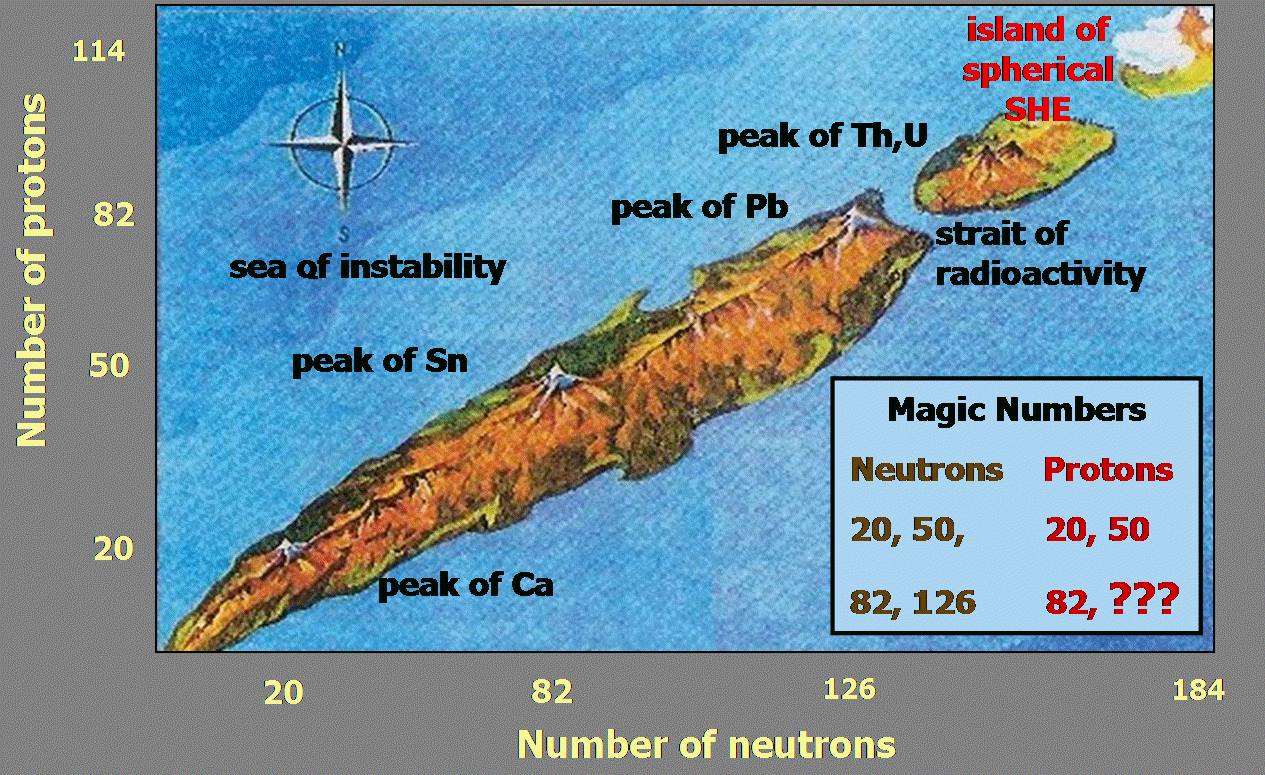

|
||
01/29/08 |
|
|
Let's talk shop!My research interest are mainly focussed on the spectroscopy of superheavy elements (SHE). Go directly to the isomer.
|
||
 |
|||
|
The study of nuclei at the limits of stability is one of the main challenges faced by nuclear structure physics. Only in the exploration of extremes are the finer details of structure isolated and identified. One such extreme is that of high mass and charge the regime of superheavy elements (SHE). The question whether an island of stability exists for nuclei with more than 100 protons and where the borders of such an island may lie has been at the centre of nuclear physics for nearly half a century and is still one of the most fascinating and elusive open questions in modern physics.
|
|||
 |
In a naļve first step the
liquid drop models in various parametrizations predict the limits of
spherical stability somewhere around Z=100-106 where the long-range Coulomb
repulsion between the protons overcomes the short range attraction of the
strong nuclear force. Extra stability comes from the microscopic shell
corrections and a lot of effort is focused on the best description and
extrapolation of the mean field far from the well studied nuclei around Z=92
to those with the largest masses. Here various approaches favour different
spherical proton and neutron magic numbers: e.g. Z=114, N=184, or
Z=124,126 and N=184, or Z=120, N=172, depending on the model approaches
used. (Picture taken from S. Cwiok et al, Nuclear Physics A 611 (1996) p 211) |
||
|
One major challenge to experimental investigations is the increasing difficulty with which heavier SHE can be produced. Fusion evaporation reactions give low cross sections as the product of fusion cross section and survival probability becomes increasingly smaller. For the most part, structure information has mainly been derived from the study of alpha decay fine structure. Here the selective population of states with a similar single-particle structure as the mother state has allowed studies aimed at the systematic mapping of single-particle orbitals close to the ground state in a large number of nuclei. The main difficulty in this approach lies in the assignment of spins and parities from just the alpha decay observables such as energies and hindrance factors alone. The heaviest nucleus in which a direct measurement of the ground state spin has been made via optical spectroscopy measuring the hyperfine splitting is 253Es. More commonly one has to rely on an evaluation of decay chains over a wide range of nuclei and comparison with the very theories one wishes to constrain. Thus this method alone generally does not pin down configurations.
|
|||
|
One further, indirect approach is open to the study of SHE. In the deformed nuclei around 254No (Z=102) the deformed Nilsson orbitals built on spherical single particle levels around Z=120 come down in energy and lie at or close to the Fermi surface. Here the sequence of levels at a deformation β2 ≈ 0.3 probes the 7/2-[514]p, 9/2+[624]p, 1/2-[521]p and 5/2-[512]p states stemming from the spherical 1h9/2, 1i13/2, 2f5/2 and 2f7/2 proton orbitals, respectively. The 2f7/2-2f5/2 spin-orbit partners are especially important here, because the strength of the spin-orbit interaction governs the size of a possible Z=114 shell gap. In addition, the strongly downsloping low-Ω levels stemming from the spherical 1i11/2 and 1j15/2 orbitals well above Z=126 come close to the Fermi level, and the structure of the well deformed nuclei in the nobelium region will depend strongly on variations in the energies of those spherical orbitals. In our recent work we were able to pinpoint a level in 254No that involves the 2f5/2 proton orbital which sits directly above the spherical Z=114 gap (RDH et al., nature 442 (2006) 896, see also here and here for additional commentary.
|
|||
|
The nuclei around 254No
combine several advantages that make them ideal study cases: first, they can
be produced with relatively large cross sections of 0.2-2 µb, which is
sufficient for modern in-beam spectroscopic techniques. Secondly, we now
know that they do remain stable against fission even at large angular
momenta I ≈ 20ħ. Several nuclei, even-even as well as odd-N and odd-Z are
available for systematic study.
|
|||
| This research is carried out worldwide. A collection of external links can be found on the Links page | |||
|
A recent review article on the subject was voted one of
the IoP's Physics Highlights of 2004 and is available in pdf form here:
Physics
Highlights 2004 or directly here:
JPhysG30_2004_R123.pdf
|
|||
|
Together with our colleagues in Daresbury and Jyväskylä we build the SAGE spectrometer to allow simultaneous in-beam gamma-ray and conversion electron spectroscopy.
|
|||
|
Experimental Details about the nuclei we have studied so
far: (Coming soon)
|
|||
|
External Links to Experimental SHE Research activities: (Coming Soon)
|
|||
| Other Research Interests: | |||
| ECOS (European Consortium for Stable Beams) | |||
| FAIR @ GSI | |||
| EURISOL | |||
| ISOLDE @ CERN | |||
| SPIRAL2 @ GANIL | |||
This site was last updated 01/09/08